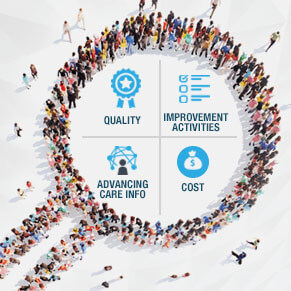
December 31st, 2017 was the last day to collect data for Medicare’s new Quality Payment Program. The next key date is March 31, 2018 as this date marks the last day to submit data to Medicare. Of course, the next logical question is: what to report.
Let’s simply cover the MIPS track as trying to explain MIPS and APMS may be too much for this setting. Under MIPS (Merit-based Incentive Payment System) there are four categories (categories):
- Quality
- Advancing Care Information
- Improvement Activities
- Cost
Quality. Quality is a key category as the same counts for as much as 60% of the total score. Under this category eligible clinicians can opt to report up to 6 quality measures, including an outcome measure for 90 days. Groups using the web interface can report 15 quality measures for a full year. There are 271 measures to choose form. Some of the easiest to comply with and most commonly use are:
- Age appropriate screening colonoscopy
- Breast Cancer Screening
- Care Plan
- Closing the referral loop: Receipt of Specialist Report
- Controlling High Blood Pressure
- Diabetes: Eye Exam
- Diabetes: Foot Exam
- Documentation of Current Medications in the Medical Record
- Preventive Care and Screening: Body Mass Index (BMI)
- Preventive Care and Screening: Influenza Immunization
- Preventive Care and Screening: Tobacco Use: Screening and Cessation
Recommended actions regarding this category include but are not limited to:
- Review and select measures that best fit your practice.
- Use CMS Quality Payment Program website to select and calculate your points
- Download a CSV file of the measures you have selected for your records.
- Keep electronic and hard copies of your measures.
Advancing Care Information. Advancing Care Information should be your second priority as this category counts for as much as 25% of your total score. This category is a little tricky as there are two measure set options for reporting.
- Advancing Care Information Objectives and Measures (15 measures)
- 2017 Advancing Care Information Transition Objectives and Measures (11 measures)
Regardless of the option selected eligible clinicians must report on a set of five required measures, referred to as base measures. Failure to report any of the base measures will result in a score of zero for this category. The base measures for this category are:
- Security Risk Analysis (HIPAA Security Risk Analysis)
- e-Prescribing
- Provide Patient Access
- Send Summary of Care
- Request/Accept Summary of Care
In addition to the base measures eligible clinicians can choose to submit up to 9 additional measures for a minimum of 90 days for additional credit.
Recommended actions regarding this category include but are not limited to:
- Review and select measures that best fit your practice.
- Use CMS Quality Payment Program website to select and calculate your points
- Download a CSV file of the measures you have selected for your records.
- Keep electronic and hardcopies of your measures.
Improvement Activities. Improvement Activities is the third category with a value of up to 15% of the total. This is a new category and points for the same are given based on care focused on care coordination, beneficiary engagement, and patient safety. Eligible clinicians can attest that they completed up to 4 improvement activities for a minimum of 90 days. Groups with fewer than 15 participants or eligible clinicians in a rural or health professional shortage area can attest completion of up to 2 activities for a minimum of 90 days.
Under this category there are 93 measures to choose from. Some of the measures that have the greatest appeal include:
- Annual Registration in the Prescription Drug Program
- Completion of the AMA STEPS Forward Program
- Diabetes Screening
- Implementation of co-location PCP and MH Services
- Implementation of use of specialists reports back to referring clinician or group
- Tobacco Use
- Unhealthy alcohol use
- Use of telehealth services that expand practice access
Recommended actions regarding this category include but are not limited to:
- Review and select measures that best fit your practice.
- Use CMS Quality Payment Program website to select and calculate your points
- Download a CSV file of the measures you have selected for your records.
- Keep electronic and hardcopies of your measures.
Cost. The last category, Cost requires no submission of data as the required information will be gathered from adjudicated claims. We also do not focus on this category at this time as the same has not been assigned any points for the 2017 performance period.
As you can see, based on the previous information, MACRA is not simple nor easy to implement. Each track has multiple decision-making points, specific requirements, measures and documentation requirements. Those that take the time to learn may benefit from their efforts, the opposite is also true. In short, we simply repeat what may seem like our mantra: if you are going to play the game, learn the rules.
